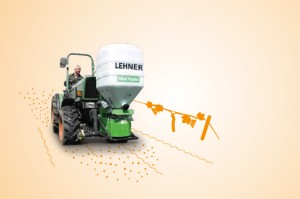It used to be that if you wanted to spread road grit over large areas in winter, you had two options: hydraulically or mechanically driven spreader machines. The associated carrier vehicles with hydraulic drive or cardan shaft are often high-maintenance and relatively expensive – too expensive for many municipalities or businesses. In many places this meant grit had to be spread by hand – with unsatisfactory results: more use of material, uneven distribution and, last but not least, high burdening of the personnel. The call for a cost-effective alternative grew loud.
New niche
LEHNER Agrar developed the solution. More than 10 years ago the family-owned company began by developing attachable spreader machines for nearly all types of vehicles, from small ATVs, to conventional cars, to full-fledged fire engines. But what this company on the edge of the Ostalb region in Baden-Wuerttemberg actually specialised in was the trade of seeds, fertilisers and pesticides. The shift to tinkering and puzzling can be justified in a typically Swabian, pragmatic way: The core business of LEHNER Agrar is subject to strong seasonal fluctuations, which regularly led to a low workload in winter. When the managing directors rather accidentally became aware of the potential of manageable spreader machines, they decided to engage in pioneering work in this field. Thus LEHNER Agrar solved two problems at once: full-time employment for the staff and the opening up of a new, lucrative business sector.
The technical approach of LEHNER Agrar is also pragmatic. The “Polaro ” spreader machine simply uses an energy source already in the vehicle: electrical current. The Polaro draws its power entirely from the alternator via the vehicle’s voltage socket. This is how it drives an electric motor which transfers the energy to a rotary table. Its rotational speed determines how far the road grit flies. The user can regulate this process continuously in order to effectively cover narrow walkways as well as large-area parking lots.
Failure rate: zero
What sounds quite simple in theory involved a few little pitfalls in the development. With up to 3,000 revolutions, the electric motor must provide a substantial output, after all, but must not burden the carrier vehicle’s circuit with currents that are too high. Otherwise a 12-volt car battery would very quickly reach its limits. When it came to designing a corresponding motor for the spreader machine, LEHNER developers received support from ebm-papst in St. Georgen. “Since the device has to run under relatively adverse ambient conditions, we decided in favour of a robust BCI motor,” explains Thomas Schrag, Branch Manager for Drive Engineering at ebm-papst. St. Georgen.
“This brings along with it the necessary energy efficiency to keep from overloading the circuit.” Nevertheless, the St. Georgen staff together with their partners at LEHNER Agrar closely examined the application once more to further optimise the efficiency in the relevant areas of performance. The BCI motor persuaded the developers with its good controllability and long service life with minimum maintenance effort. “To date we have not had a single complaint,” confirms Schrag.
With these convincing arguments it is only logical that the “POLARO” would turn into an absolute sales hit for LEHNER Agrar. Though only 100 units were sold in the first year, one year later it was already 1,000. They didn’t leave it at just one model for long. Additional specialised spreader machines followed, such as for combating agricultural pests or for fire engines. The export of spreading technology now makes up 40 percent of their business, and the trend is rising.



Leave a comment